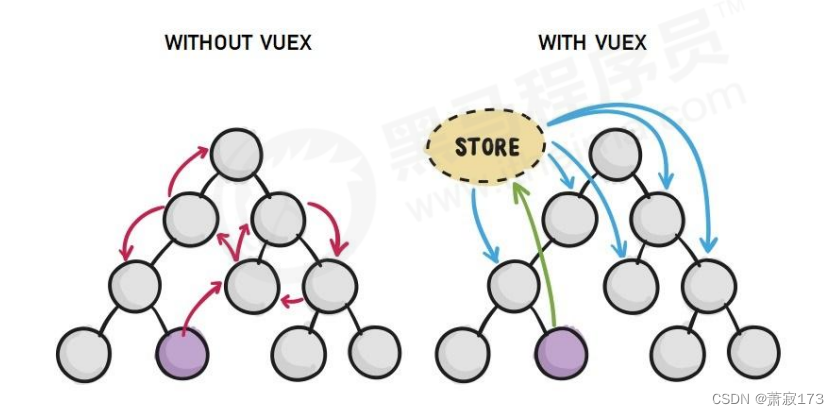vue全家桶之vuex详解
| 阿里云国内75折 回扣 微信号:monov8 |
| 阿里云国际,腾讯云国际,低至75折。AWS 93折 免费开户实名账号 代冲值 优惠多多 微信号:monov8 飞机:@monov6 |
文章目录
Vuex 概述
1.1 组件之间共享数据的方式
父向子传值v-bind 属性绑定
子向父传值v-on 事件绑定
兄弟组件之间共享数据 EventBus
- $on 接收数据的那个组件
- $emit 发送数据的那个组件
1.2 Vuex 是什么
Vuex 是实现组件全局状态数据管理的一种机制可以方便的实现组件之间数据的共享.

1.3 使用 Vuex 统一管理状态的好处
① 能够在 vuex 中集中管理共享的数据易于开发和后期维护
② 能够高效地实现组件之间的数据共享提高开发效率
③ 存储在 vuex 中的数据都是响应式的能够实时保持数据与页面的同步
什么样的数据适合存储到 Vuex 中
一般情况下只有组件之间共享的数据才有必要存储到 vuex 中对于组件中的私有数据依旧存储在组件自身的 data 中即可。
2. Vuex 的基本使用
1. 安装 vuex 依赖包
npm install vuex --save
2. 导入 vuex 包
import Vuex from 'vuex'
Vue.use(Vuex)
3. 创建 store 对象
const store = new Vuex.Store({
// state 中存放的就是全局共享的数据
state: { count: 0 }
})
4. 将 store 对象挂载到 vue 实例中
new Vue({
el: '#app',
render: h => h(app),
router,
// 将创建的共享数据对象挂载到 Vue 实例中
// 所有的组件就可以直接从 store 中获取全局的数据了
store
})
3. Vuex 的核心概念
3.1 核心概念概述
Vuex 中的主要核心概念如下
- State
- Mutation
- Action
- Getter
3.2 State
State 提供唯一的公共数据源所有共享的数据都要统一放到 Store 的 State 中进行存储。
// 创建store数据源提供唯一公共数据
const store = new Vuex.Store({
state: { count: 0 }
})
组件访问 State 中数据的第一种方式
this.$store.state.全局数据名称
组件访问 State 中数据的第二种方式
// 1. 从 vuex 中按需导入 mapState 函数
import { mapState } from 'vuex'
通过刚才导入的 mapState 函数将当前组件需要的全局数据映射为当前组件的 computed 计算属性:
// 2. 将全局数据映射为当前组件的计算属性
computed: {
...mapState(['count'])
}
3.3 Mutation
Mutation 用于变更 Store中 的数据。
① 只能通过 mutation 变更 Store 数据不可以直接操作 Store 中的数据。
② 通过这种方式虽然操作起来稍微繁琐一些但是可以集中监控所有数据的变化。
// 定义 Mutation
const store = new Vuex.Store({
state: {
count: 0
},
mutations: {
add(state) {
// 变更状态
state.count++
}
}
})
// 触发mutation
methods: {
handle1() {
// 触发 mutations 的第一种方式
this.$store.commit('add')
}
}
可以在触发 mutations 时传递参数
// 定义Mutation
const store = new Vuex.Store({
state: {
count: 0
},
mutations: {
addN(state, step) {
// 变更状态
state.count += step
}
}
})
// 触发mutation
methods: {
handle2() {
// 在调用 commit 函数
// 触发 mutations 时携带参数
this.$store.commit('addN', 3)
}
}
this.$store.commit() 是触发 mutations 的第一种方式触发 mutations 的第二种方式
// 1. 从 vuex 中按需导入 mapMutations 函数
import { mapMutations } from 'vuex'
//通过刚才导入的 mapMutations 函数将需要的 mutations 函数映射为当前组件的 methods 方法
// 2. 将指定的 mutations 函数映射为当前组件的 methods 函数
methods: {
...mapMutations(['add', 'addN'])
}
3.4 Action
Action 用于处理异步任务。
如果通过异步操作变更数据必须通过 Action而不能使用 Mutation但是在 Action 中还是要通过触发Mutation 的方式间接变更数据。
// 定义 Action
const store = new Vuex.Store({
// ...省略其他代码
mutations: {
add(state) {
state.count++
}
},
actions: {
addAsync(context) {
setTimeout(() => {
context.commit('add')
}, 1000)
}
}
})
// 触发 Action
methods: {
handle() {
// 触发 actions 的第一种方式
this.$store.dispatch('addAsync')
}
}
触发 actions 异步任务时携带参数:
// 定义 Action
const store = new Vuex.Store({
// ...省略其他代码
mutations: {
addN(state, step) {
state.count += step
}
},
actions: {
addNAsync(context, step) {
setTimeout(() => {
context.commit('addN', step)
}, 1000)
}
}
})
// 触发 Action
methods: {
handle() {
// 在调用 dispatch 函数
// 触发 actions 时携带参数
this.$store.dispatch('addNAsync', 5)
}
}
this.$store.dispatch() 是触发 actions 的第一种方式触发 actions 的第二种方式
// 1. 从 vuex 中按需导入 mapActions 函数
import { mapActions } from 'vuex'
通过刚才导入的 mapActions 函数将需要的 actions 函数映射为当前组件的 methods 方法
// 2. 将指定的 actions 函数映射为当前组件的 methods 函数
methods: {
...mapActions(['addASync', 'addNASync'])
}
3.5 Getter
Getter 用于对 Store 中的数据进行加工处理形成新的数据。
① Getter 可以对 Store 中已有的数据加工处理之后形成新的数据类似 Vue 的计算属性。
② Store 中数据发生变化Getter 的数据也会跟着变化。
// 定义 Getter
const store = new Vuex.Store({
state: {
count: 0
},
getters: {
showNum: state => {
return '当前最新的数量是【'+ state.count +'】'
}
}
})
使用 getters 的第一种方式
this.$store.getters.名称
使用 getters 的第二种方式
import { mapGetters } from 'vuex'
computed: {
...mapGetters(['showNum'])
}

